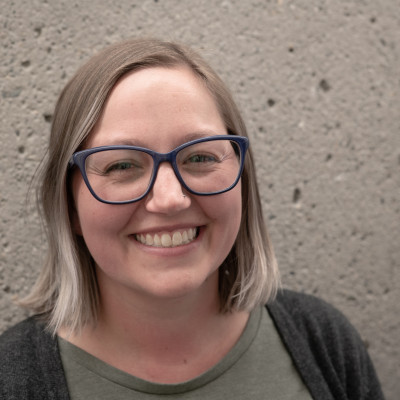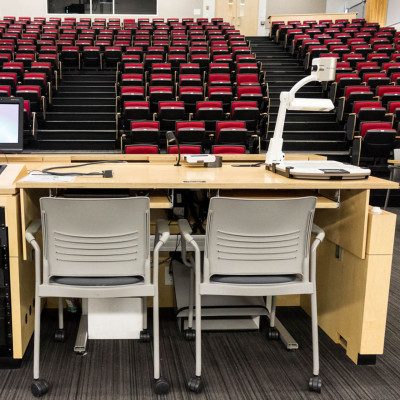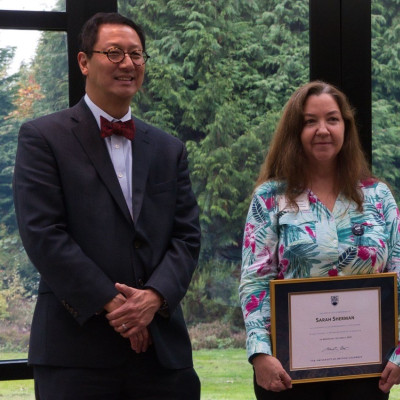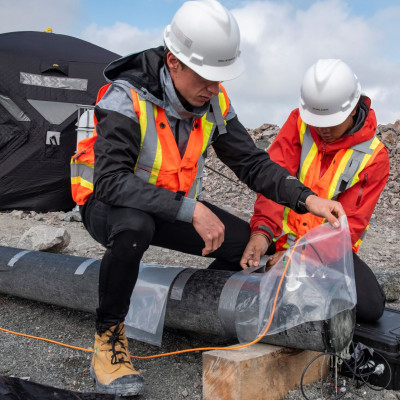News
Stay up-to-date with what's happening in EOAS
Unstructured rest key to student learning at field school
Fieldwork is renowned for its long hours and grueling pace, but working without breaks leads to exhaustion and errors. Science Teaching and Learning Fellow Alison “AJ” Jolley is investigating how students rest during field courses, and how it impacts learning.
Jolley has fond memories of her time at the Department of Earth, Ocean and Atmospheric Sciences’ Oliver Field School from her undergraduate in geology. “It made me feel really connected to the science and to geology,” she explains about the experience that gave her the confidence to pursue a career in geoscience education. “I really liked it so much, I just want to make it a better kind of camp!”
She dug into how students connect with the places they do fieldwork for her doctoral research at the University of Canterbury in New Zealand under the supervision of UBC alum Ben Kennedy before returning to Vancouver to keep digging into how students’ emotional experiences, attitudes, and values impact the way they learn.
Field courses are often jammed full of learning opportunities, explains Jolley, but downtime is a hazier concept. Her current research collaboration with Alex Watson at the University of Canterbury started when field instructors grew concerned that travel days between field sites were becoming synonymous with rest. So Jolley headed to the field to observe students in camp.
“We thought that students would be tired before the rest day and energized afterwards, and it would be pretty straightforward,” she explains. “But there's a whole bunch of nuances to the way people feel about it.”
Some students took their day off to energetically socialize, investing their waking hours in getting to know other people in the camp. Others took that time off to retreat away from everyone, investing their rest period in recuperation or in connecting with their distant support network at home. But both groups returned refreshed and convinced that their efforts had paid off.
Jolley captures this split path to the same outcome as students sharing a common goal of wanting to contribute to their group and to intensively learn science, but that their way of getting there is unique. “This really speaks to us needing to give students time where they have choice to figure out what they want to do instead of prescribing activities,” explains Jolley.
It's these unexpected moments that Jolley treasures most about researching how students learn geoscience. “There's so much richness and depth to what people do and say and feel that it keeps you guessing all the time,” she says.
Image credit: Mika McKinnon
Media Contact: Mika McKinnon media@eoas.ubc.ca
10 Tips to Rapidly Transition to Remote Education
With many universities transitioning to remote education to reduce risk during the COVID-19 pandemic, educators are faced with abruptly converting their face-to-face courses. Here are the top tips from our experts on rapidly making the transition.
1. Do what you can now. Worry about making it better later.
Like many aspects of disaster preparedness, anticipating future needs and working in advance is far less stressful than trying to reactively adapt to changing conditions. Ideally, converting an existing face-to-face course to remote education is done with time and resources to create custom materials, testing, and iteration to work with the platform. Focus on adapting your course to be functional without worrying about whether it’s perfect.
Our professors are making plans in case UBC transitions to remote education for the remainder of the term. “My plan for first pass is to just record myself doing the lectures,” says Brett Gilley. “Depending on how much time we have, there's a lot more I could do with videos and embedding questions.”
2. Remote education has a lot in common with face-to-face education.
Remote education is a powerful tool that gives universities greater flexibility in how they teach students. Learning management systems have their own strengths that can engage students in a different way than traditional classes, making remote education just as effective as face-to-face courses.
Adapting your first course with little to no notice while using unfamiliar tools is not easy, but you already have the most important skills. As Francis Jones explains, the key facets of successful remote education are identical to the key facets of face-to-face education:
- Learning goals and objectives are clear.
- Students engage in meaningful and authentic tasks, not busy-work.
- Skills are developed in a well-scaffolded sequence where each task leads to the next.
- Focus is on the learning goals, not distracted by learning new software or diverging off-topic.
- Students have the ability to ask logistical and conceptual questions.
Share your enthusiasm with your students, don’t take the mistakes too seriously, and be as gentle on yourself learning a new skill as you try to be for your students.
3. Keep tools simple to stay focused on course learning goals.
It’s easy to get distracted by the hunt for the perfect tool, software, or learning management system integration, but everything new requires a learning curve for both professors and students. Instead, try to stick to familiar tools and spend your creativity on how you’re going to apply those tools to explore your course objectives. Sticking to familiar tools will also reduce technological issues in case students have older hardware or limited internet connection.
“Keep it simple, especially if implementing some new-to-you technology for the first time,” says Sara Harris. “Practice your setup, so you find the trouble spots and can troubleshoot before it's high stakes.”
If you do want to experiment with novel technology, make sure to use it more than once. It is difficult to get student buy-in for one-off tasks, so reward their efforts with repeated use.
Similarly, Science Education Specialist Sarah Bean Sherman recommends keeping content just as focused. “Try to keep from overwhelming students with uploading a lot of content that doesn't line up with learning goals,” she says. “It is overwhelming for faculty as well, but it is really important to be careful and thoughtful.”
4. Social motivation is more powerful than solo motivation.
Learning remotely doesn’t need to be a solitary task. Discussion forums provide an avenue for students to ask questions, process the material, and share insights.
Try full-class forums for class-wide discussions and small-group forums accessible to smaller sets of students for groupwork or workshops. You might be surprised by how many more students participate when they have time to formulate their questions compared to the awkward silences that can come with the rapid pace of face-to-face learning. In an online context, Jones and colleagues found small groups of 8 students are more engaged than groups of 4 students.
Make sure to have ungraded forums to handle logistical problems. Experiment with graded forums to encourage participation on course content. Don’t underestimate the motivating power of less tangible feedback: upvotes, public validation from the teaching team, or virtual prizes like memes or .gifs can promote engagement and enhance course culture.
Avoid the trap of answering every question. Instead, encourage peer-teaching through students answering each other’s questions. But don’t be too hands off! Moderate discussions to stay on topic, intervene with misconceptions, and enforce civil behaviour.
You can also experiment with video conferences for discussion sections if you have a more Socratic dialogue teaching style. You can adapt peer assessments to online courses with tools within your learning management system (such as Peer Review Assignment in Canvas), or have students download and annotate PDFs of each others’ work.
5. Video is the remote version of face-to-face interactions.
Pre-recorded videos can be an effective substitution for lectures. “Creating videos of mini-lectures may seem intimidating or perhaps make instructors feel self-conscious about themselves being captured on video, but this can be quite doable,” reassures Sherman. She recommends experimenting with screen capture using either tools built in to your learning management system, or using the “Record Slide Show” feature in PowerPoint or Keynote to create a movie with synchronized audio and slides. She also suggests breaking up lectures into multiple shorter videos, each focused on a learning goal, to make them less intimidating than a single long video.
Streaming videos or video conferences can allow for live interaction with your students, either allowing them to ask questions or to participate themselves. Remember that you can point the camera at a piece of paper or use screen sharing with a tablet to do worked problems, just like you’d use a document camera in large lecture halls.
If recording yourself, make sure you’re in a bright room and check your background for distractions. For best results, have the camera level with you or pointing slightly down (not a laptop at desk height pointed up your nose!). An external microphone can greatly improve sound quality, but even a cellphone will provide adequate audio and video.
6. You can still do active learning when you’re remote!
Try setting up active reading by loading assigned material into your learning management system broken up by embedded questions or followed by low-stakes quizzes. You can also set up discussions (video or forums) focused on readings, trading off which student is the discussion leader just like you would with a classroom journal club. If you’re looking for additional readings, BC Open Textbooks are peer-reviewed creative commons licensed textbooks on a variety of topics, including environmental science, geology, oceanography, and meteorology.
Similarly, you can adapt worksheets for online use either by setting them up as quizzes in your learning management system, with either embedded instructions or separate downloadable files for more complicated instructions.
Laboratories, field trips, or accessing archival materials are tricky to convert to remote learning, but you can take advantage of virtual field trips, virtual collections, or online simulators. The exact resources will change depending on your discipline, but some our department finds useful include activities we developed, our Pacific Museum of the Earth’s virtual tours, Arizona State University’s virtual field trips, University of Colorado Boulder’s simulators, Royal Museum Ontario’s Burgess Shale fossil gallery, GeoSci.xyz’s collection of geophysics resources, Smithsonian Natural History Museum’s virtual tour (first floor for the Hall of Fossils), and Holocene Adventure’s virtual field trips and games.
“It’s really easy to create a virtual field trip in Google Earth,” says Gilley. “Like, shockingly easy.” A virtual field trip can take the place of an already-planned but now cancelled field trip by setting waypoints within a Google Earth map, he explains, or professors can take advantage of the freedom from budget constraints to create a new field trip anywhere on the planet. You can optionally annotate the stops, and have students use worksheets or online assignments to make observations similar to how they’d participate in a traditional field trip.
Here are more of our tips on converting face-to-face activities for distance education.
7. Pay attention to emerging problems.
Small problems can spiral as students miss out on content while struggling with technology issues. “Pay attention to student logistical challenges and seek early help to resolve them,” says Harris.
Ignoring problems blocks students from accessing course materials, leading to the falling farther behind until the technology issues are resolved. Prioritize helping students resolve them as quickly as possible, and don’t be shy about recruiting your university’s IT helpdesk to support you.
Resist the temptation to create redundancy by posting instructions in multiple places. “People are tempted to put instructions in many locations, but that tends to confuse students more because they don't have one place to go for instruction,” says Gilley. “Try to keep your navigation simple.”
8. Adapt your assessments.
Carefully supervising students to ensure exam integrity is a regular feature of face-to-face teaching, but you can still conduct meaningful student assessments remotely.
Many learning management systems have built-in security features like time limits or IP locks, but be aware these aren’t guarantees of exam integrity. Also be aware that these limitations are vulnerable to technology disruptions, so be prepared to address technological problems.
For very large classes, try to automate assessments or incorporate peer assessment to ease your workload and ensure students get timely feedback.
If you’re comfortable with social media, consider how you can adapt classroom exercises to the online environment to harness the motivating power of social validation. Try assigning students to editing and improving Wikipedia pages as research projects, or developing TikTok videos or meme collections as study aids.
If your final exams will be remote, consider if you can modify end-of-term assessments into take-home or open book exams, or final projects. Including an integrity pledge at the start of the project can be helpful in encouraging honesty, says Sherman.
Don’t be shy about keeping it simple. “Students can just take a photo of their work and upload it,” says Sherman, a technique she finds particularly useful when students are creating diagrams.
9. Be accessible to all your students.
It’s easier for students to fall through the cracks when you can’t see their confused faces. Take extra care that you are supporting all your students with your transition to remote education.
Keeping tools simple will help reduce problems, as can understanding your students’ technology limitations before you get too invested. Survey your students to learn their hardware and internet access. You may be surprised how many are accessing the learning management system from a phone, or only have limited internet access.
Make sure to incorporate any existing student accommodations with your online material. Try turning on the auto-transcription features to get an accompanying lecture transcript, but be sure to proof-read it as it often garbles scientific terms. Similarly, enable and provide image descriptions. If any of your students have individual accommodations for in-person exams, make sure to check settings on how to customize online assessments to incorporate those accommodations.
Leave your learning management system’s language unspecified for it to default to the student’s language preferences. This will allow students who have weaker language skills to see the navigation controls in their preferred language.
From his experience teaching science at the international student-focused Vantage College, Gilley recommends streamlining communication. “Paradoxically, less communication is better,” he advises. “Make sure you don’t send 15 short messages. It's better to have things in one message because it actually takes a lot of effort to read any given communication.”
Similarly, you can take this opportunity to pay attention to how much jargon you use while teaching. Decide which terms are strictly necessary as part of the learning goals, and which material can be taught with more streamlined language.
10. You aren’t alone.
Many educators are facing this exact same challenge as you. Check out discussion on #covidcampus and #covidclassroom on Twitter for more ideas, to ask questions, or just get condolences and sympathy.
UBC’s Keep Teaching initiative is a collection of resources on how to move your course experience online for all forms of disruptions from pandemics to inclement weather. It includes step-by-step guides and demonstration videos on how to use the Canvas learning management system.
The Earth Science Women’s Network is also crowd-sourcing geoscience remote teaching resources, which you can browse here. Daniel Stanford of DePaul University is crowd-sourcing general remote teaching resources, which you can browse here. The Science Education Resource Center and National Association of Geoscience Teachers are also compiling resources at Geo Teach Online.
Jenae Cohn and Beth Seltzer of Stanford University have also assembled a guidance document for teaching effectively during times of disruption.
Geoscience education research is an important component of our department. Science Education Specialist Sarah Bean Sherman helps instructors improve student learning through creating activities, analyzing surveys on student learning, exploring creative ways to enhance curriculum delivery. Professor of Teaching and Associate Dean Academic for the Faculty of Science Sara Harris blends her interest in science education and climate change to develop the Massive Open Online Course (MOOC) “Climate Change: The Science” on edX. Science Teaching and Learning Fellow and Acting Director of the Pacific Museum of the Earth Francis Jones focuses on developing better practices for distance education courses. Senior Instructor and Chair of Science at Vantage College Brett Gilley uses his experience to teach science in English-primary and multilingual environments.
Some of the resources we value are developed by our education research alumni who are continuing to push the boundaries of science education at their new academic homes. Former postdoctoral fellow Ben Kennedy now leads the Earth and Environmental Education group at University of Canterbury researching place-based education, community engagement, and multicultural pedagogy, and gamification, including the Holocene Adventures field trips and games. Former postdoctoral fellow Joshua Caulkins is now Assistant Director for Undergraduate Programs in the Life Sciences Department at Arizona State University, home of an extensive collection of virtual field trips and interactive labs, where he improves evidence-based teaching practices and develops adaptive learning software.
For more tips and ideas, check out our Science Education Initiative blog, our starting guide to improving existing courses to reflect current best pedagogical practices that focus on student learning, and the UBC campus-wide science education resources developed as part of the Carl Weinman Science Education Initiative.
Image credit: UBC Learning Spaces.
Media Contact: Mika McKinnon, media@eoas.ubc.ca.
Sarah Bean Sherman awarded UBC President's Staff Award for Advancing Diversity and Inclusion
Congratulations to our very own Sarah Bean Sherman for winning the 2019 President's Staff Award for Advancing Diversity and Inclusion.
Sarah Bean Sherman is a strong advocate for inclusive teaching practices at UBC.
In her work with EOAS and Skylight, as well as her involvement in CTLT and the wider campus teaching and learning community, Bean applies an equity lens to everything she does and champions inclusion for all faculty, staff and students.
Through her daily interactions and teaching practice, Bean builds respectful and inclusive environments. In meetings and in the classroom, Bean ensures that all voices are heard and makes space for everyone to contribute. She pays close attention to the ways in which social structures and systems of power often encourage unbalanced input, particularly when it comes to decision-making. When Bean notices that someone is not being heard or even invited to contribute, she is quick to facilitate and encourage them.
In her capacity as EOAS Science Education Specialist, Bean not only helps faculty integrate inclusive practices in their work, but also increases their capacity to adopt these attitudes and practices. By creating environments that facilitate honest and open conversations, Bean is changing the landscape of how faculty think about equity, diversity and inclusion in their teaching practices, and how it impacts students as they actively engage in academic life at UBC.
Source: http://focusonpeople.ubc.ca/2019/08/26/2019-presidents-awards-for-staff-recipients/#Sherman
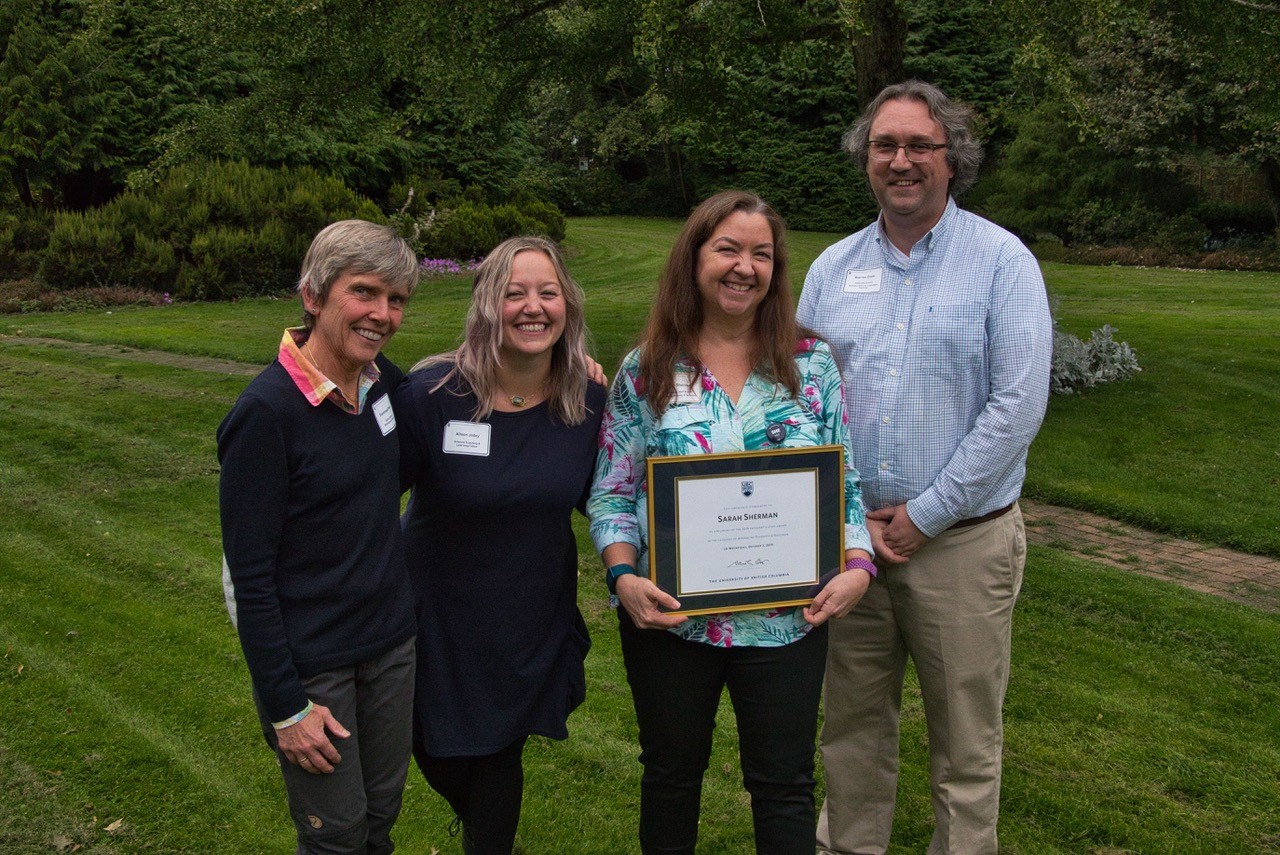
The nomination team with the awardee (left to right) : Dominique Weis, Alison Jolley (AJ), Bean Sherman and Warren Code
Photo credit: Dominique Weis
EOAS Statement on Global Climate Strike
The UBC Department of Earth, Ocean and Atmospheric Sciences (EOAS) is a global leader in research and education advancing understanding of the Earth system. Our faculty, students and research staff work on the front-lines of global change, examining the unprecedented anthropogenic impacts on the oceans, atmosphere and land, and developing innovative approaches for climate mitigation and the sustainable use of Earth’s natural resources. We believe that scientific expertise must inform public debate and policy on global environmental issues.
EOAS recognizes the existence of a climate crisis, which demands coordinated and determined global action. In the face of overwhelming scientific evidence, society must urgently take steps to avoid the worst potential outcomes of anthropogenic climate change. We thus support those students, faculty and staff who will gather outside the Earth Sciences Building at 10:30 on September 27 to stand in solidarity with the Global Climate Strike. EOAS students will be organizing a sign making event at 9 AM in the undergraduate club space (EOAS Main, room 208), with light breakfast snacks provided. In addition, the UBC Climate Hub is hosting a Climate Solutions Showcase on Thursday the 26th, featuring a wide range of climate-focused workshops and talks. We encourage department members to participate in these events and show their support for the global climate solidarity movement.
While EOAS supports the climate strike, we also believe that education and research are essential to understand the scope of global climate change, and develop new solutions for mitigation and adaptation. Following the policy outlined by UBC, the EOAS department will remain open on Sept. 27, continuing to advance its teaching and research mission. A number of EOAS classes on that day will focus on climate change issues, bringing diverse expertise and perspectives to bear on this critical problem. Academic concessions will be made for those students who miss class in order to join the Global Climate Strike.
Philippe Tortell
Professor and Head
DFO-UVic-UBC underwater glider records unusually warm temperatures on maiden Pacific trip
Wall-e, an autonomous underwater glider operated by Department of Fisheries and Oceans, University of Victoria and UBC researchers, recorded anomalously warm temperatures on its maiden 880 kilometre trip to Station Papa in the North Pacific.
The glider collects valuable data that measures ocean temperature, salinity, deep-water productivity, and tracks oxygen levels, all down to a depth of 1,000 metres. Wall-e has been out during the recent marine heatwave—an expanse of warm water building off the West Coast that stretches roughly from Alaska to California.
Wall-e is one of several robotic gliders that are part of the Canadian-Pacific Robotic Ocean Observing Facility, a CFI/BCKDF-funded project to build autonomous ocean observing capacity off the British Columbia coast. UBC oceanographers involved in leading the project include Stephanie Waterman, Roger Francois and Philippe Tortell.
Read the blogpost from the C-PROOF team:
http://cproof.uvic.ca/deployments/StationPapa.html
Read more about C-PROOF at UBC EAOS:
BRIMM Carbon Sequestration Project Awarded Clean Growth Funding from Government of Canada
BRIMM’s Carbon Sequestration research project, led by BRIMM Director & UBC Professor Greg Dipple, has received $2 million in funding from the Government of Canada as a part of the Clean Growth Program. This project is also supported by Geoscience BC, the British Columbia Geological Survey (BCGS), the Geological Survey of Canada (GSC), De Beers Canada FPX Nickle Corp., and Giga Metals Corp. and is a collaboration between the University of Alberta, Trent University and Institut national de la recherche scientifique (INRS).
The funding was announced on July 23rd, 2019 in Yellowknife, N.W.T. with Director and researcher Greg Dipple present.
In the photo, the carbon dioxide bearing bas is circulated through the pipeline containing reactive tailings. Carbon dioxide is removed from the cas before it exits the end of the pipe. The carbon is captured in the form of a solid mineral precipitate.
